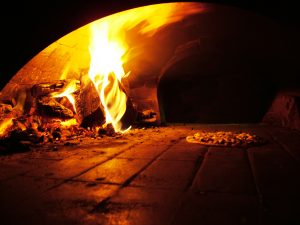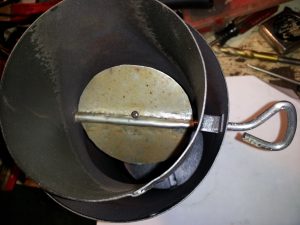
The Tuscan Outdoor Oven. The name says it all; Italian flag waving, huge brick ovens with delicious pies being whisked directly from under the flickering flames, still steaming and bubbling directly to the plate in front of you. But why not The Napoli Outdoor Oven? After all, the pizza was invented in Naples-or at least its most famous one, the mozzarella, basil and tomato pie named after Queen Margherita. And the people of Napoli are nothing, if not deadly serious about their pizzas. Where else would you find a Comission, the Associazione Vera Pizza Napoletana, which defines pizza for all the world, down to each ingredient and where they are grown, each preparation technique-what’s allowed and not allowed-its exact dimensions, etc.? Our little oven is not so lucky to be in that league so I am sure that calling it The Napoli Outdoor Oven would have sparked an international conflict of opus proportions. Moving a bit north but staying within the Italian border we can still have some association, so The Tuscan Outdoor Oven, our $199 wonder it is-even if Tuscany is more famous for other things.
So here’s a bit about our pizza quest: We’ve been attempting pizza at home for some time now with varied success. The one problem has always been that the oven is a critical factor in making the perfect pizza. All the perfect ingredients in the world won’t come together right without the proper way to cook them. Our kitchen oven, even with the various modifications (stones, tiles, etc.) still can’t duplicate the heat levels and patterns that a true brick, wood-fired pizza oven has. What makes those ovens special is that the heat level rises upwards of 1,000 degrees and more, with the shape concentrating the heat in the stone ceiling. The porous floor is actually several hundred degrees cooler and during cooking wicks the moisture away from the bottom of the pizza, cooking it at a slower pace while the hotter ceiling cooks the upper part of the pizza faster. That’s why pizzas come out the way they do. One other important point is that all of that hot stone stays exactly to temp, unlike our pizza stone in our a regular oven which instantly drops as soon as the dough hits it. While true pizza ovens do their magic in mere few minutes, it takes hours to get all of that brick and stone mass to temp. So there it is; very high but controlled overhead heat plus a stone floor that will not waiver in temp once the dough hits are what comprises the critical keys to perfect pizza making. That is what we are trying to duplicate, be it on a much more modest scale.

In our quest for the perfect pizza, naturally I’ve looked at plans to construct an authentic wood-fired oven. Yes, it can be done on a smaller scale suitable for a backyard, but like its Napoli cousin, it’s still pretty big and still requires long hours of prep for a few moments of glory. Maybe in the end that will be the only way, but for now we are in search of something that fires up a bit (read a lot) faster. The closest thing to a (relatively) instant pizza oven for the home is a gas one made by a company called Kalamazoo which looks great and seems to have the right stuff but at $6,495 is way out of price for our back yard. Yes, I could haunt the used restaurant supply houses for a commercial one, but we don’t have a place in the kitchen for it nor the natural gas service to drive it. Enter the $199 Tuscan Outdoor Oven.
Studying the construction and the very few reviews that I could find, The Tuscan Outdoor Oven showed enough promise to make it worth a try. Reading the reviews I could see that there will have to be some modifications but I’ll get to that soon enough. For now I just needed to get one.

Only available through Sam’s Club at the moment with none in store stock I wound up having to order one on line. With shipping and tax the price soon rose north of $250, but oh, well. When it arrived damaged, I arranged to have it returned. Our local Sam’s club coincidentally now had them in stock so I picked one up, only to find concealed damage. So with the third one in hand and fingers crossed, I started assembly. Ok, is this thing a joke? I hope not.The metal used in the base is truly flimsy as in HVAC duct-work flimsy, you can easily bend this stuff by hand, flimsy. The actual oven appears a bit more sturdy, but questions still linger. In the end, if it proves to be acceptable for pizza-making, it is going to be built into our outdoor kitchen so the stand will not be used.


On to the oven modifications: The first complaint in the reviews that I read was that the oven just didn’t get hot enough. The burner seems big enough but as one person noted, the rather large chimney let way too much heat escape. When the reviewer put aluminum foil over it, the temp rose into the 600+ degree range, much more suitable for pizza making than the 450 range that the manufacturer claims. You need heat for a good pizza, so my first modification was to make and install a damper into the chimney. Since you do need some air flow for the gas burner I made the fit loose enough that in the closed position it will block off only 90-95% of the exhaust. We should get a good, high heat range with the damper in place. But there is one other thing in the construction that intrigued me; the oven is double-walled with a 1-3/4″ cavity open along the entire bottom and also vented to the chimney. I am sure that the purpose is to keep the outer wall cool but I see it as the perfect place to add insulation to stop thermal bounce and this was the one feature that prompted me to buy it in the end. Now the search for a suitable insulator was on: At first I considered doing the vermiculite/portland cement mixture that real pizza ovens use but this is pretty heavy and messy and besides, I don’t know if I can get enough insulating with only about 2″. The alternative is ceramic fiber “wool”, used in ovens, firewalls, etc. I found a source on eBay and while it is going to add a about $70 to the cost of the oven, it should do the trick and at 8lbs, won’t add significant weight so I’ve ordered some. Next up is the pizza stone itself. Given that mass is critical to keep from getting thermal bounce from the cooler dough, I am looking into additional tiles to help keep the stone from dropping temp as the pizza is placed on it.
So, for now we wait for things to arrive. In theory I think that we are on the right track but the tale will be told once the first pizza hits the stone. Will we have done enough to get the heat high enough and the stone not to bounce too much? Stay tuned for “That which is Pizza, Part 2.”
